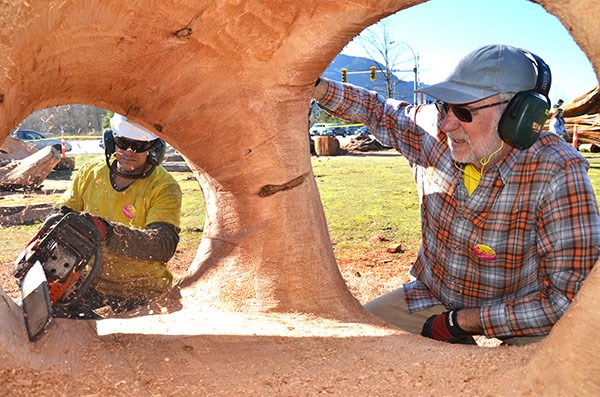��
Renowned Brazilian woodcarver Hugo França admitted to being just a tiny bit overwhelmed by the reception he received in Squamish last week.
At an event on Thursday (March 27) marking the kickoff for the town’s involvement in the two-year-long Vancouver Biennale arts initiative, a smiling França stood up in front of an overflow crowd at the Squamish Academy of Music to offer his thanks for the warm welcome on his first visit to Canada.
After the audience of around 120 people — educators, elected officials, business leaders and arts enthusiasts — listened with rapt attention to França’s beautifully lilting Portuguese, the microphone was passed to Taís Ribeiro, França’s colleague and interpreter.
Ribeiro said França “now feels more responsible about the results” of the work he and his team were about to undertake at the “teardrop” property in downtown Squamish, “because he can now see how important this project can be to this region, for Squamish.”
The following morning, França and his team — also including Jhony Dos Anjos and Jailton Procopio — braved a light drizzle to launch into the work of creating six pieces of distinctive “sculptural furniture” from four large pieces of cedar wood that had been placed on the vacant lot in front of Squamish Elementary School.
França is to be the first of three internationally renowned artists who will visit Squamish during the next two years —��the others being fellow Brazilian Vik Muniz, whose work was featured in the 2010 documentary film Waste Land, and Australian Konstantin Dimopoulos of “Blue Trees” fame.
Squamish’s participation in the third Vancouver Biennale will also include visits from 15 to 20 up-and-coming “artists in residence” from around the world.
França was working as an industrial engineer for a computer company in the city of São Paulo until 1981. At age 26, he moved to the community of Trancoso, in the northeastern coastal area of Bahia, to live among the indigenous Pataxó people, according to a New York Times profile.
He began working with wood from tropical trees that had already fallen — the first few were actually canoes that had been discarded by the natives, Ribeiro said.
Franca’s work is featured in indoor and outdoor public spaces around the world, with the largest share at the Inhotim Instituto Cultural in Brumadinho, Brazil.��
Fittingly for Squamish, though, one of his main woodworking tools is a chainsaw, which he and his team use to carve out the basic form of the piece — normally a bench whose shape is determined by the natural form of the tree itself, with a helping hand from Franca’s creative instincts.
“It’s a new use for the chainsaw, which is normally used for cutting down,” França said. “We are, in essence, using it to reverse the process, as a sculptural tool — to create.”
In Brazil, França normally works with “pequi” or souari nut wood, a tropical tree that produces an edible fruit, or with “imbuia” or Brazilian walnut. Both are hardwoods with lots of irregularities, which often results in complex, organically shaped pieces, he said.
Krisztina Egyed, Squamish liaison to Vancouver Biennale, said that before the group arrived on March 19, Squamish resident Bryan Couture identified about a dozen large fallen trees for possible use. França and his team then chose from among them. Initially, both cedar and fir pieces were identified — but because fir trees often grow up with rocks inside their trunks, they decided to focus on the cedar.
Working with cedar is “like butter,” França said, adding that because it’s so different from what he’s used to, it will present its own challenges.
França told The Chief each project is about striking a balance between what the fallen tree has to offer and his own creativity.
“It’s a balance between the heavy-ness of the material and the lightness of the drawing,” Ribeiro said in translation. “It’s difficult to explain, but it’s a very natural and organic process.
“It’s very much a creative dialogue.”
França’s team expected to wrap up its work in Squamish on Wednesday (April 2). Egyed said all of the pieces França creates will remain here through the two-year Biennale period. After that, some will remain permanently in town and some will be sold, she said.




